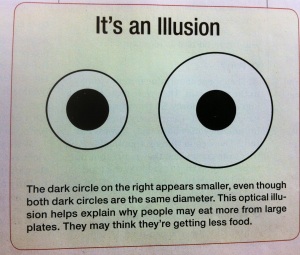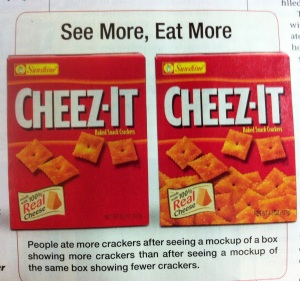The exciting finale from the article published in April, 2013 by the Center for Science in the Public Interest. Professor Wansink of Cornell University was interviewed by CSPI.
When last you visited us, the focus was on “What… makes people happy with fewer calories?’. The focus was home. Here are additional arenas and strategies (home is addressed here too!) to keep you ahead of being fooled.
- Fast Food Restaurants: A study was done where the results showed that when people ate at a fast food restaurant, in soft light, they ate eighteen percent fewer calories and they rated the food more appealing. The reason: It is hypothesized that since they stayed in the restaurant (during the study) 9 minutes longer with the changed ambiance, they were more relaxed and they ate more slowly. Their satiety cues caught up given more time: perhaps they realized their fullness & stopped eating. Additionally, the food may have become cold and less appealing (french fries in a fast food joint) so they stopped eating. The people may have had enough. This works at home too. The more relaxed the environment, the more relaxed you are, you eat more slowly, and you end up eating less (use quiet music, low TV sound, candlelight, etc.)
- Sit Down Restaurants: Usually people spend more time in sit down restaurants than in fast food places. Interestingly, according to Professor Wansink’s book: “Slim by Design”, thinner people sit near windows and in lighter, well-traveled parts of the restaurant. Heavier people sit near the TV, bar, and in dark corners. In these spots, they spend more time, which may explain why they are over eating.
Bottom line: Be as relaxed as you can in your eating environment, focusing on eating, i.e. your speed & quantity ingested (also ENJOYING!). Try to sit in the open when you are out at a sit down place. You probably won’t find low light/quietness at McDonald’s, so eat slowly & enjoy & pay attention to your body’s cues 😉
- Stress! For college students, it was found that they generally eat healthier when they arrive on campus. As the year goes on, they slowly begin eating less healthy. It is, in part, because of final exams. More than that, though, it is because of the overload of papers and projects throughout the entire year. In similar observations of stress with non-college students, i.e. holidays, it was found that people stress eat because of the apprehension of having family visit, having to buy presents, having to finish projects.
Bottom line: Be aware! Discover stress relief that does not involve eating. Try: yoga, meditation, “Am I really hungry?”, keep a food diary, get support from the people around you, take a walk, watch a movie, listen to music, surf the internet, call a friend, don’t keep unhealthy food in the house/near you (go out and have them as a treat), make set-backs turn into positive experiences…..
- Keeping food on your desk. Don’t do it (common sense)! People who have a bowl of chocolate sitting on their desk eat about 125 more calories per day than if the chocolate is just six feet away.
- Grocery Shopping. Studies have shown that people really do NOT buy more when you grocery shop hungry. BUT they buy fewer healthy foods, and more convenient, highly processed food that they can eat quickly (breakfast cereals, frozen food, Hamburger Helper, candy, and crackers). They stay away from fruits, vegetables, and healthy dairy. The mere thought of how long it would be before they would be able to eat a chicken/vegetable stir-fry sways them to buy the fast, convenient, generally higher calorie/fat/sodium/sugar foods.
Want to know more? Professor Wansink has a new book: “Slim by Design: Mindless Eating Solutions for Everyday Life”. The premise: 80% of the food we buy is within ~3 miles of where we live (food radius). Choose the 5 places that cause you to overeat (they can be home and work along with the grocery store or a restaurant). Make small changes in each of these places. You can become slim by design!
And the last word on this series…. There is now a Slim by Design Global Registry: www.SlimByDesign.org It registers people who have been slim all of their lives. By studying the habits, patterns, tips, and attitudes of these people, their goal is to help others learn some secrets and insights they have used to stay slim. Use it as a resource!


